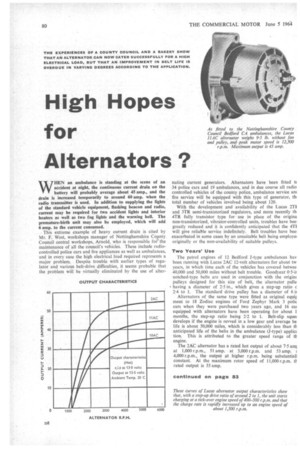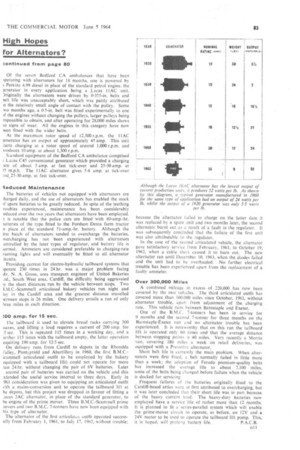High Hopes for Alternators ?
Page 82

Page 85

If you've noticed an error in this article please click here to report it so we can fix it.
WHEN an ambulance is standing at the. scene of an accident at night, the continuous current drain on the battery will probably average about 45 amp., and the drain is increased temporarily to around 60 amp. when the radio transmitter is used. In addition to supplying the lights of the standard vehicle equipment, flashing beacon and radio, current may be required for two accident lights and interior heaters as well as two fog lights and the warning bell. The premature-birth unit may also be employed, which will add 6 amp. to the current consumed. This extreme example of heavy current drain is cited by Mr. F. West, workshops manager of Nottinghamshire County Council central workshops, Arnold, who is responsible for the maintenance of all the council's vehicles. These include radiocontrolled police cars and fire appliances as well as ambulances, and in every case the high electrical load required represents a major problem. Despite trouble with earlier types of regulator and various belt-drive difficulties, it seems probable that the problem will be virtually eliminated by the use of alter
nating current generators. Alternators have been fitted ti 34 police cars and 19 ambulances, and in due. course all radio controlled vehicles of the county police, ambulance service am fire service will be equipped with this type of generator, th, total number of vehicles involved being about 120.
With the development and availability of the Lucas 21'I and 3TR semi-transistorized regulators, and more recently th 4TR fully transistor type for use in place of the origina non-transistorized, vibrator-controlled units, troubles have beel greatly reduced and it is confidently anticipated that the 4T1 will give reliable service indefinitely. Belt troubles have beei exacerbated in some cases by an unsuitable belt being employe originally or the non-availability of suitable pulleys.
Two Years' Use
The petrol engines of 12 Bedford J-type ambulances hay been running with Lucas 2AC 12-volt alternators for about tw years, in which time each of the vehicles has covered betwee 40,000 and 50,000 miles without belt trouble. Goodyear 0.5-is notched-type belts are used in conjunction with the origins pulleys designed for this size of belt, the alternator pulle t having a diameter of 2.5 in., which gives a step-up ratio c 2:4 to 1. The standard drive pulley has a diameter of 6 it
Alternators of the same type were fitted as original equil ment to 18 Zodiac engines of Ford Zephyr Mark 3 polic cars when they were purchased two years ago, and 16 eat equipped with alternators have been operating for about 1 months, the step-up ratio being 2.2 to 1. Belt-slip squel develops if the engine is revved in a low gear and average be life is about 50,000 miles, which is considerably less than tI anticipated life of the belts in the ambulance (7-type) applia tion. This is attributed to the greater speed range of tin engine. ,
The 2AC alternator has a rated hot output of about 7.5 arnj at 1,000 r.p.m., 51 amp. at 3,000 r.p.m. and 53 amp. 4,000 r.p.m., the output at higher r.p.m. being substantial constant. At the maximum rotor speed of 11,000 r.p.m. ti rated output is 55 amp.
Of the seven Bedford CA ambulances that have been werating with alternators for 18 months. one is powered by Perkins 4,99 diesel in place of the standard petrol engine, the generator in every application being a ,Lucas 11AC unit. 3riginally the alternators were driven by 0-375-in. belts and 3elt life was unacceptably short, which was partly attributed o the relatively small angle of contact with the pulley. Some wo months ago, a 0-5-in, belt was fitted experimentally to one )f the engines without changing the pulleys, larger pulleys being mpossible to obtain, and after operating for 28,000 miles shows to signs of wear. All the engines in this category have now )een fitted with the wider belts.
At the maximum rotor speed of 12.500 r.p.m. the 11AC generator has an output of approximately 45 amp. This unit ;tarts charging at a rotor speed of around 1,000 r.p.m. and )roduces 10 amp. at about 1,300 r.p.m.
S:andard equipment of the Bedford CA ambulance comprised t Lucas C45 conventional generator which provided a charging :ate of about 5 amp. at fast tick-over and 25-30 amp. at 35 m.p.h. The 11AC alternator gives 5-6 amp. at tick-over tnd_25-30 amp. at fast tick-over.
Reduced Maintenance
The batteries of vehicles not equipped with alternators are :harged daily, and the use of alternators has enabled the stock )f spare batteries to be greatly reduced. In spite of the teething roubles experienced, maintenance has been considerably 'educed over the two years that alternators have been employed. t is notable that the police cars are fitted with 80-amp.-hr. ranches of the type fitted to the Fordson Dexta farm tractor n place of the standard 51-amp.-hr. battery. Although the irst batch of alternators tended to overcharge the batteries, ivercharging has not been experienced with alternators :ontrolled by the later types of regulator, and battery life is tormal. Ammeters are considered preferable to charging-rate Yarning lights and will eventually be fitted to all alternator :ircuits.
Providing current for electro-hydraulic tailboard systems that werate 230 times in 24 hr. was a major problem facing dr. N. A. Gross, area transport engineer of United Bakeries _td., South West area, Cardiff, the difficulty being aggravated ty the short distances run by the vehicle between stops. Two 3.M.C.-Scammell articulated bakery vehicles run night and lay in the Cardiff area and the greatest distance travelled tetween stops is 26 miles. One delivery entails a run of only hree miles in each direction.
100 amp. for 15 sec.
The tailboard is used to elevate bread racks carrying 300 caves, and lifting a load requires a current of 200 amp. for 5 sec. This is repeated 115 times in a working day, and a urther 115 times with the tailboard empty, the latter operation equiring 190 amp. for 12-5 sec. On delivery runs from Cardiff to depots in the Rhondda /alley, Pontypridd and Abertillery in 1960, the first B.M.C.lcammell articulated outfit to be employed by the bakery equipped with a tailboard lift) could not operate for more han 24 hr. without changing the pair of 6V batteries. Later . second pair of batteries was carried on the vehicle and this xtended the useful service interval to three days. Early in 961 consideration was given to equipping an articulated outfit yith a mains-conversion unit to operate the tailboard lift at he depots, but this project was dropped in favour of fitting a _ucas 2AC alternator, in place of the standard generator, to he engine of the prime mover. Three B.M.C.-Scammell prime 'lovers and two B.M.C. 7-tonners have now been equipped with his type of alternator.
The alternator of the first articulatef. outfit operated successLilly from February 1, 1961, to July 17. 1962, without trouble;
because the alternator failed to charge on the latter date it was replaced by a spare unit and two months later, the second alternator burnt out as a result of a fault in the regulator. It was subsequently concluded that the failure of the first unit was also attributable to the regulator.
In the case of the second articulated vehicle, the alternator gave satisfactory service from February, 1961, to October 19, 1962, when a cable short caused it to burn out. The new alternator ran until December 10, 1963, when the diodes failed and the unit had to be overhauled. No further electrical trouble has been experienced apart from the replacement of a faulty ammeter.
Over 300,000 Miles
A combined mileage in excess of 220,000 has now been covered by the two vehicles. The third articulated outfit has covered more than 100.000 miles since October. 1961, without alternator trouble, apart from adjustment of the charging rate. This vehicle runs between Barnstaple and Exeter.
One of the B.M.C. 7-tonners has been in service for 9 months and the second 7-tonner for three months on the Barnstaple-Exeter run and no alternator trouble has been experienced. It is noteworthy that on this run the tailboard lift is operated only 60 times and that the average distance between stopping points is 40 miles. Very recently a Morris van, covering 180 miles a week on retail deliveries, was equipped with a Prestolite alternator.
Short belt life is currently the main problem. When alternators were first fitted, a belt normally failed in little more than a week; the adoption of Ferodo premium-quality belts has increased the average life to about 7,100 miles, some of the belts being changed before failure when the vehicle is docked for servicing.
Frequent failures of the batteries originally fitted to the Cardiff-based artics were at first attributed to overcharging, but it was later concluded that their short life was in part because of the heavy current load. The heavy-duty batteries now employed have a service life of rather more than 12 months. It is planned to fit a series-parallel system which will enable the prime-mover circuit to operate, as before, on 12V and a 24V motor to be used to operate the tailboard lift pump. This,
it is hoped. will prolong battery life. P.A.C.B.












































































































































































